Rhinoceros horn carving @ Sotheby's. Fine Chinese Ceramics & Works of Art, 11 May 11
A carved rhinoceros horn libation cup. 17th century. .Photo Sotheby's
of flaring U-shape resting on a flat base, carved with a gnarled tree forming the handle with associated leaves continuing over the rim, the exterior decorated in relief with a sage and an acolyte set within a landscape, with further trees rising from rockwork amid a cloud mist, the horn of rich toffee tone darkening to a dark chocolate tone at the base; 16cm., 6 1/4 in. Estimate 50,000—70,000 GBP. Lot Sold 181,250 GBP
PROVENANCE: Christie's Rome, 7th May 1981, lot 45.
A finely carved rhinoceros horn libation cup. 17th century. Photo Sotheby's
in the form of a large veined lotus leaf, the exterior naturalistically carved with a lotus blossom and pod issuing from stalks and a branch of pomegranate in high relief, the base formed of stylised water ripples, the horn of a deep chestnut tone; 16cm., 6 1/4 in. Estimate 40,000—60,000 GBP. Lot Sold 133,250 GBP
A rare rhinoceros horn 'Mallow-Flower' libation cup. 17th century. Photo Sotheby's
carved in the form of a large mallow blossom with a leafy branch running parallel to a bamboo stalk to form a handle, a serrated star-shaped leaf at the tip of the branch extending over the rim to the interior of the cup, the exterior carved with a sinuous chilong clambering among buds and leaves on entwined branches extending up from the openwork stalk base, the horn of rich toffee tone; 18.2cm., 7 1/8 in. Estimate 100,000—150,000 GBP. Lot Sold 121,250 GBP
NOTE: Rhinoceros horn cups in the form of the musk mallow flower are rare, although another vessel in this catalogue, lot 22, is similarly decorated with chilong amongst this attractive flower. For further examples of vessels decorated with the mallow flower see a cup sold at Christie's London, 15th December 1980, lot 38; and another sold in our Hong Kong rooms, 20th May 1981, lot 903. The musk mallow design, with its softly rounded flower petals and serrated finger-like leaves is easy to identify through the classic botanical literature of the Bencao gangmu (Compendium of Materia Medica) by Li Shizhen (1518-1593) of the Ming dynasty. It was already used on Yongle period ceramic vessels, such as the ewer in the Topkapi Saray Museum, Istanbul, illustrated in Regina Krahl, Chinese Ceramics in the Topkapi Saray Museum. Istanbul, London, 1986, pl. 617.
While this cup displays characteristic elements seen on flower-form vessels, such as the interior fashioned in the form of overlapping petals, the carving of the foot is especially attractive and worth noting. The artisan has created an openwork design whereby the stalk of the plant is made into a ring-base for the piece. Nature was also on the forefront of the carver's mind when he rendered the leaves that are shown folding over as if blown by the wind.
The generous size of this piece indicates that it was made from the horn of an Asian rhinoceros species. The flaring rim of the cup suggests that the horn used may have come from the Great Indian rhinoceros.
A carved rhinoceros horn 'Eight Immortals' libation cup. 17th century. Photo Sotheby's
of oval section with flaring sides, carved to the exterior in high-relief with Shoulao riding a crane flying above a recumbent deer, flanked on the sides by the Eight Daoist Immortals standing on linked ruyi cloud scrolls, the horn of chocolate tone: 13.7cm., 5 3/8 in. Estimate 80,000—120,000 GBP. Lot Sold 109,250 GBP
NOTE:A number of rhinoceros horn cups, carved with the popular 'Eight Daoist Immortals' motif, can be found in important museums and private collections. For example see one in the Chester Beatty Library, Dublin, illustrated in Jan Chapman, The Art of Rhinoceros Horn Carving in China, London, 1999, pls. 270-272, where the author discusses the theme and significance of this design. Another related cup, in the collection of the Osaka Municipal Museum, Osaka, is included ibid., pl. 266; and a third, from the collection of Thomas Fok, is published in Thomas Fok, Connoisseurship of Rhinoceros Horn Carving in China, Hong Kong, 1999, pl. 82. The Fok cup was previously sold in our Hong Kong rooms, 1st June 1994, lot 161.
Compare also a cup carved in high relief and in openwork around the sloping sides of the vessel with Shoulao riding a crane and the Eight Immortals around the exterior of the vessel, each bearing an attribute, offered at Christie's Hong Kong, 30th May 2006, lot 1504.
A rare rhinoceros horn 'Chilong' libation cup. 17th century. Photo Sotheby's
of flaring U-shape, carved around the exterior with two chilong supported on stems of leafy bamboo and lingzhi fungus, the handle in the form of another chilong clutching a lingzhi sprig in its mouth clambering up a bamboo and a lingzhi stalk, further extended to form a base with various lingzhi heads, the horn of rich dark toffee-coloured tone; 16.2cm., 6 3/8 in. Estimate 60,000—80,000 GBP. Lot Sold 91,250 GBP
A massive carved full-tip rhinoceros horn 'Lotus' libation cup. Qing dynasty, 19th century. Photo Sotheby's
the deep U-shaped cup in the form of a veined lotus leaf, borne on a long curved stem profusely carved in openwork with a cornucopia of intertwining lotus flowers and stalks, the base carved in the form of a cupped lotus leaf, the horn of warm chestnut tone, carved wood stand; 84.5cm, 33 1/4 in. Estimate 60,000—80,000 GBP. Lot Sold 73,250 GBP
NOTE: The present piece is impressive for its deeply undercut form and exceptionally large size. The carver has skilfully made use of the entire length of the horn with the solid tip transformed into the stem of the plant. Expertly carved with attention paid to details, such as the curled edges and veins running through the leaves, the varying surface textures and the interlocking forms combine to create an attractive piece.
The lotus plant is one of the most popular decorative themes in the rhinoceros horn carvers' repertoire. Homonymous with the word for peace, the lotus (he) is symbolic of the pure and elevated character of virtuous gentlemen and thus appealed greatly to the gentry and literati.
For examples of related full-tip rhinoceros horn cups see one on loan in the Durham University Oriental Museum, illustrated in Jan Chapman, The Art of Rhinoceros Horn Carving in China, London, 1999, p. 73, pl. 38, where the author notes that the cup may have been commissioned by a European who demanded the largest and longest possible horn with the maximum amount of bravura carving. Compare also a cup sold in our New York rooms, 5th June 1985, lot 131; a pair sold in these rooms, 4th May 1984, lot 279; and one similarly pierced in openwork sold in our Los Angeles rooms, 26th October 1977, lot 779.
An extremely rare rhinoceros horn carving of a finger citron . Qing dynasty, 19th century or earlier. Photo Sotheby's
naturalistically carved rising from gnarled leafy stems, the surface of the fruit less polished and skilfully pricked with shallow holes to imitate its natural uneven texture, the horn of dark chocolate tone; 16.3cm., 6 3/8 in. Estimate 40,000—60,000 GBP. Lot Sold 55,250 GBP
NOTE: This carving is impressive for the carver's ability to manipulate the rhinoceros horn into the form of a gnarled finger citron and no other related example appears to have been published. Such carvings of finger citron are more commonly known in ivory and jade; see an ivory example from the Robert H. Blumenfield collection sold at Christie's New York, 25th September 2010, lot 816; and a jade version sold in our Hong Kong rooms, 8th April 2010, lot 1905.
The Buddha's hand citron is a popular motif in China and takes its name from the shape of its fruit that resembles the idealised fingers of the Buddha. It has a strong fragrance and is used as an altar offering during the New Year celebration. The first character of its name, fo, is a pun for fu (blessings and riches), while the second character shou is homophonous with longevity.
An archaistic carved rhinoceros horn libation cup. 17th century. Photo Sotheby's
of flaring U-shape with lobed sides raised on a slightly spreading foot, carved in shallow relief around the exterior with a band featuring pairs of interlinked circular discs framed by four ruyi heads at the top, the flat strap handle flanked by two chilong clambering up the side of the cup into the interior, the base encircled with a keyfret border, the horn of rich toffee tone darkening at the base; 10.3cm., 4 1/8 in. Estimate 8,000—12,000 GBP. Lot Sold 46,850 GBP
A carved rhinoceros horn bowl. Qing dynasty. .Photo Sotheby's
the deep rounded sides rising from a flat base to a straight rim, the translucent horn of light honey tone with a patch of ink-coloured inclusion in the centre; 10.5cm., 4 1/8 in. Estimate 8,000—12,000 GBP. Lot Sold 22,500 GBP
Sotheby's. Fine Chinese Ceramics & Works of Art, 11 May 11, London www.sothebys.com

/https%3A%2F%2Fprofilepics.canalblog.com%2Fprofilepics%2F1%2F0%2F100183.jpg)



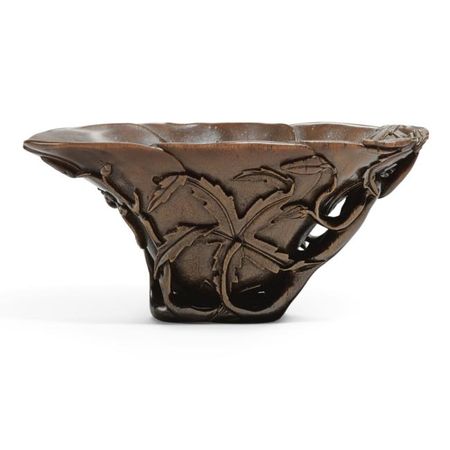


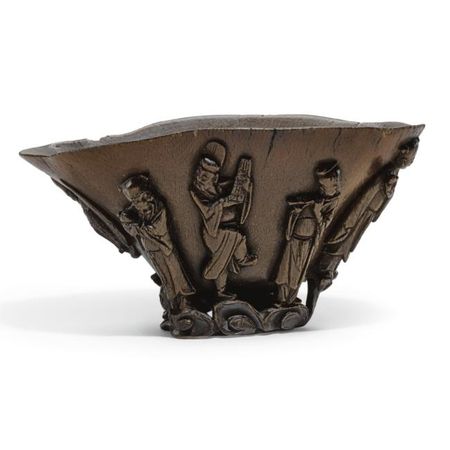
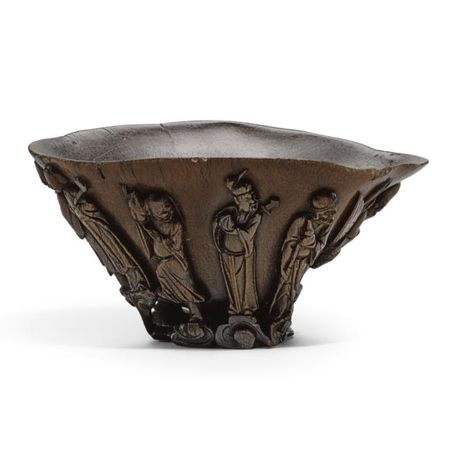



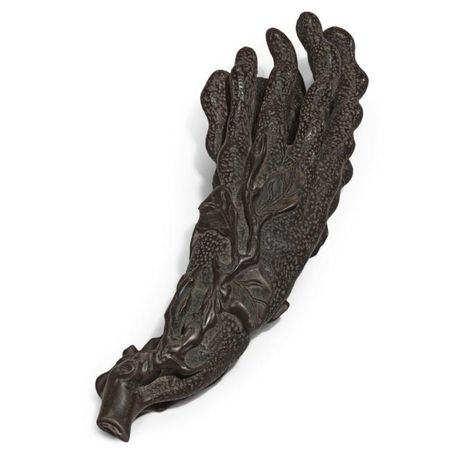
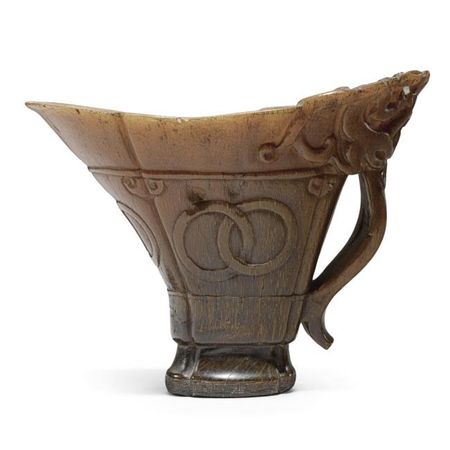
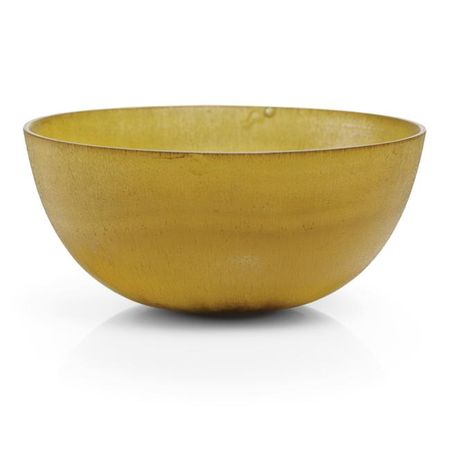


/http%3A%2F%2Fstorage.canalblog.com%2F34%2F01%2F577050%2F66379918_o.jpg)
/http%3A%2F%2Fstorage.canalblog.com%2F04%2F00%2F119589%2F66268897_p.jpg)
/http%3A%2F%2Fstorage.canalblog.com%2F05%2F37%2F119589%2F66268549_p.jpg)
/http%3A%2F%2Fstorage.canalblog.com%2F86%2F30%2F119589%2F66187962_p.jpg)